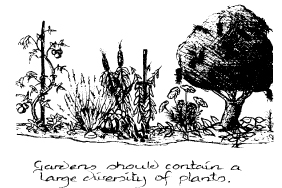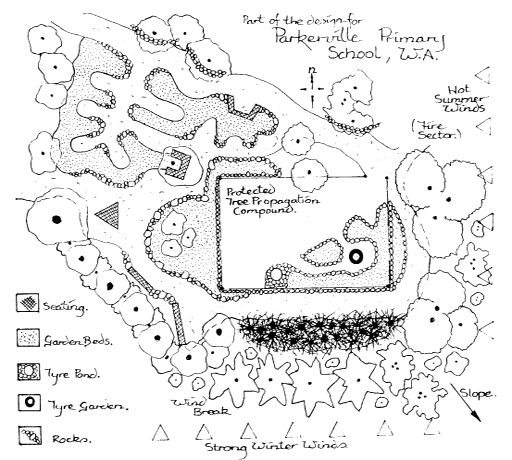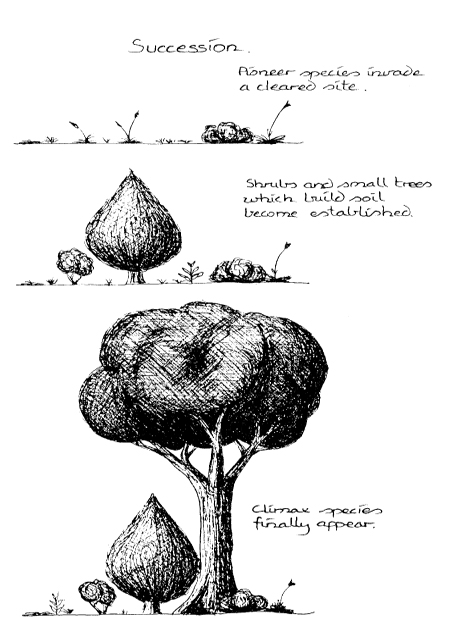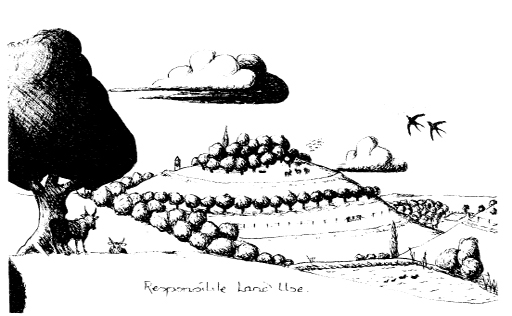
1 Permaculture is a direction, not a destination
What permaculture is and what it is not
Permaculture deals with our existence on this planet and it encompasses many different aspects of this. Firstly, permaculture is about producing edible landscapes, mirroring the natural ecosystems in their diversity and production. Permaculture is primarily a design system. This is the main difference between it and all other agricultural and horticultural practices. Permaculture designs endeavour to integrate all components of the ecosystem in a holistic approach to sustainable living and practice.
Permaculture started out as permanent agriculture and thus focussed on the growth and development of perennial food crops. Annuals and biennials do have their place, but the use of long-livingfood crops, such as fruit and nut trees, is the priority. Some areas of the garden need to be devoted to annuals and in most cases they can be interplanted between the perennial herbs and other trees as companion planted guilds. Too often, annuals are taken for granted in food production and they should be used in the system within the framework of perennial production.

Figure 1.1 A garden should have diversity of annuals and perennials.
Permaculture is not just about gardening, although its origin of permanent agriculture suggests this. Nowadays, permaculture is thought of along the lines of permanent culture, incorporating all aspects of human beings and human settlements.
Gardening, however, is one simple way in which people can take some responsibility for their own existence and begin to care for the Earth. Helping yourself and others to build gardens in your own backyard, in an effort to drastically reduce the need to buy produce from someone else, is one of the most environmentally-responsible things you can do to help reduce our consumption of resources and to heal the planet.
Since the late seventies the concepts of permaculture have also developed, such that it encompasses finances, water harvesting, communities, buildings, and alternative and appropriate technology. For many of us, permaculture is a framework that unites many disciplines, and so the subjects of aquaculture, ethical investment, horticulture, solar technology, soils, and many others can be integrated together, each contributing as part of the whole.
This framework permits many different forms of knowledge to be interwoven - all relative to one another. It is not a set of techniques per se, but rather how a number of techniques are employed to build a system in which energy is harvested, directed and allowed to flow, bearing in mind that it is always cheaper to conserve energy than to produce it. Permaculture is also different from both organic gardening and forest gardening in that both of these are techniques of garden construction and composition. Permaculture is more than this. It is a design strategy.
Permaculture is the harmonious integration of design with ecology. The ethics of earth care, people care, limits-aware and surplus-share are common to all permaculturists, even though the design strategies and the techniques they employ vary widely. We design for long term sustainability, and this is why a design is a harmonious integration of landscape, plants, animals and humans, as well as the placement of components or elements in recognisable patterns.
Truly successful designs create a self-managed system. A large amount of what we call permaculture is really just commonsense, using human intuition and insight to solve problems that confront us.
The outcomes of good design should include:
• sustainable land use strategies, without wastes and pollution.
• established systems for healthy food production, and maybe some surplus.
• restoration of degradedlandscapes, resulting in conservation of endemic species - especially rare and endangered species.
• integration and harmony of all living things on the property - all things live in an atmosphere of cooperation or interact in natural cycles.
• minimal consumption of energy.

Figure 1.2 A permaculture design is more than a garden plan. It must consider all aspects of the interaction between organisms. (Part of the design of gardens at Parkerville Primary School).
The ultimate design, if there is such a thing, is the marriage of what is best for the land and what is best for the people who live there. What we call a “design” is really only a pictorial representation of the implied inter-relationships between objects, structures, plants, animals and humans. The drawing only gives information about placement and types of species and nothing about their interaction, which is the most important thing about any ecosystem.
For some permaculturists, difficulties arise because of their limited vision, their restricted world view and their world experience. There are some people who may not have had the experience of growing fruit and vegetables, nurturing the soil or building passive solar houses, yet they can come up with a plan for somebody and tell them this is what they need.
In one sense, these armchair permaculturists may be perpetuating myths about how well permaculture works, when they haven’t ever fully implemented a design themselves or observed, firsthand, the productivity of their garden. However, don’t be discouraged by this. How much more damage can you do to what’s already been done? It is better to build your gardens and grow your own food, and make mistakes, than it is to do nothing and continue to support the promotion of vast monocultures.
Designers who have ambitions to produce designs for other people, whether they are paying clients or friends or long-suffering relatives, must have the practical experience in their own backyard. Nothing beats first-hand knowledge and acquired skills from gardening, designing and building your own systems.
Again, permaculture is not just about designing gardens. It is about designing human settlements. It is a plan that endeavours to maximise and enhance human interaction with the environment that surrounds them. This plan considers all facets of human existence. Coming to the realisation that changes are needed to the ways humans live, and then facing the bold step of acknowledging that we should do something about it, is crucial for our own survival on this planet.
Many people find it difficult to accept these ideas and change their outlook. But to embrace permaculture you have to change because it requires you to look at your life and lifestyle from a different perspective. Graham Bell, well-known permaculture teacher and author from the Scottish Borders district, told me that “permaculture is not a destination, it is a direction”. You don’t suddenly “arrive” at some point to finally declare “I’m a permaculturist”. It is a life-long journey of change and growth.
We are only limited by our imagination. Each of us has the ability to make some difference in the world in which we live. There are no problems, only solutions, and sometimes we need to look at some things from a different direction, ignoring what we already know and stepping outside of our comfort zone. As they say, one person’s rubbish is another person’s resource.
Permaculture is also about designing stability and permanence. We try to use plants, on the least amount of land, that give the greatest production. While yields in a permaculture system can be high, much higher than natural bush or forest areas, there is a limit, no matter how well we design and how ingenious we are. Plants and animals have limits to their growth and production.
Having a diverse garden, meaning lots of different plants and animals in it, is no guarantee that the garden will be highly productive. Gardens may be only productive, in terms of high yields of carbohydrates, proteins and biomass, if they are consciously maintained. Left to themselves, neglected gardens quickly fall into disrepair. They may still be productive, in an ecological sense, but they may not necessarily be useful for the owner.
There is also a difference between yield and production. Garden plants can be very productive - they grow rapidly, produce lots of biomass as new leaves and extensive branches and root systems - but they might not produce a high yield. Yield, to me, is what you can actually obtain, by way of food primarily, but also by any other useable products such as dyes, medicinal treatments from herbs, or timber and firewood. While a garden may look like a jungle, you may not actually get much out of it.
Total yields in any system have both tangible and intangible components. We’ve briefly dealt with the tangible and those yields we can measure, such as mass of lemons produced by a lemon tree.
But what about those “yields” that we simply cannot measure. How do you measure a person’s health and well-being and the pleasure they derive from their garden? These intangible yields have worth which we often seem to neglect.
How can you measure the effectiveness of your passive solar house, other than comparing it to the “average” consumption of a typical house elsewhere, or the energy bills you paid in a house you once lived in elsewhere? How well would a conventional house fare if you had built this type on the property right where your solar house is? These are system yields that defy measurement.
I used to think that we had to design the most intensive, productive system possible, but nowadays I think we should aim for a system that produces just enough -just enough of what we need and a little extra which enables us the opportunity for sale, exchange or to give away.
Many people think of food gardens and self-sufficiency when they think about permaculture, but permaculture is really about sustainable living. What you learn in the garden is closely linked with natural cycles, and it also provides the opportunity to take responsibility for growing your own healthy food. Furthermore, we mustn’t forget that many plants in our permaculture systems may not be directly useful to us, but may be essential in the life cycle of insects, birds and other animals.
I don’t believe permaculture should be seen as a way in which people can become self-sufficient. The emphasis should be on people becoming self-reliant, with positive interaction and co-operation between all members within the community.
It is true that the goal of permaculture design is to create an edible landscape. Like a natural forest, our gardens should contain a mixture of both different species and different ages. How to achieve this is known as succession, and it occurs in all ecosystems.
Permaculture has been described as cultivated ecology, where humans deliberately develop cultivated ecosystems which are designed to maintain genetic biodiversity and minimise energy and matter inputs. An ecosystem describes an area and all that it contains - the living things and their non-living surroundings, such as the air, water and soil particles. For example, an examination of a pond or forest ecosystem would show the many food chains and other relationships between the organisms which live there.
In nature, most ecosystems are exceptionally fragile, and small changes, most often caused by human thoughtlessness, can destroy the system forever. This is due to the interconnectedness of the web of life. All things depend on each other in either direct or indirect ways. For example, some animals eat others, plants require nutrient wastes from animals to grow, and plants make the oxygen which all living things require.

Figure 1.3 A forest ecosystem showing some of the feeding relationships between organisms and how these organisms interact with their environment.
Energy is continuously lost from all natural ecosystems and thus must be replaced to maintain the larger numbers of interactions that occur. The sun is the source of all energy on the earth and permaculture systems are designed to capture as much of this free energy as possible. Plants are nature’s energy absorbers and storers.
Ecosystems also cycle matter. Stable, natural ecosystems have little matter input and output, meaning that organic material is not brought into the area or exported to other areas. Plants grow, die and thus return their organic matter to the soil. Permaculture systems endeavour to mimic this natural cycle by the deliberate intensive planting of a wide range of herbs, trees and shrubs. Animals complete the system so that a complex food web develops within the ecosystem.
We try to develop ecosystems which are self-perpetuating, and although they are dynamic, there is a balance of numbers of organisms within it. We say that the ecosystem is in equilibrium, even though small changes are always occurring.
Permaculture gardens change by ecological succession, but unlike nature, humans manage to direct the changes. Succession is normally the slow, progressive change in an ecosystem. When land is cleared the first plants are usually broad-leaved weeds (pioneer species) which cover, protect and shade the soil. Next come herbs and shrubs, and finally trees. Permaculture systems speed the succession process with planted herbs and trees so that the climax (final) community is achieved at a faster rate. The succession of plants and animals slowly changes and modifies the environment.
The early colonisers or pioneers, such as broad-leaved weeds, have special characteristics to survive inhospitable environments. These include:
• usually short-lived (either annuals or perennials only lasting a few years).
• not very competitive.
• unpalatable (unlikely to be eaten).
• prolific seed producers (or have persistent runners).

Figure 1.4 Succession is the gradual change in the numbers and types of plants and animals in an area over a period of time.
• defence mechanisms such as thorns or poisonous substances.
• tendency to be dynamic accumulators and to mine particular minerals from the soil.
Their role is to protect, cover and build the soil. The pioneers change the soil so that other species can follow and colonise the area too. As succession proceeds, the larger shrubs and trees, which are longer lasting and more competitive for resources such as light, water and nutrients, replace the pioneers, as shown in the figure opposite. Succession is discussed in further detail in Chapter 3.
I believe that we should do our designs to the best of our knowledge and ability and let nature take over. We might grow a nitrogen-fixing plant, such as vetch or clover, underneath a fruit tree, thinking that these will connect and all will benefit.
This naive view is what most of us hold. Nature is much more complex than this, and the relationships between plants, and between plants and animals, are very complicated; so much so that little is generally understood about how it all works. When we companion plant our fruit trees, we probably don’t realise the many other connections and interactions that occur between these types of plants and others nearby, as well as their interactions with soil organisms. For example, some nitrogen-fixing plants make the soil non-wettable. Soil particles become coated with organic matter, which repels water. When you water your garden, or when it rains, water doesn’t effectively soak into the ground. Water availability to your trees is thus reduced.
Sustainable land use occurs when the productive capacity of the land and its resource components of soil, air, water and biota are preserved, and hopefully enhanced.
The aim of your design is to develop ideas of sustainable land use, to the best of your ability, making the property as intensively productive as possible, minimising energy input or loss to the system, and hopefully allowing you or the property owner to work towards becoming partially self-reliant. The principles of sustainable farming include:
• self-sustaining systems must be developed. We want the land to be productive, year after year, but we have to look after it for this to occur.
• diversity. The property should be about one-third arable or horticultural and two-thirds stock and fodder. This is true for much of Europe and less true in Australia where a larger proportion for stock is usually allocated as most soils are poorer and rainfall is less frequent. These figures will vary, depending on the climate, soil and other factors, but they include a large proportion of trees (30%) which should be planted in every site.
The ratio of land use activities does depend on factors such as these, and examining the annual rainfall and soil type in a particular location will allow the determination of appropriate ratios of stock and other farming pursuits.
• net yield must be high. A good surplus provides income and this contributes to the standard of living.
• small size. This gives more productivity per unit area and is easier to manage.
One person can possibly manage 10 ha (25 acres) of intense farming, but would have difficulties looking after 40 ha (100 acres) with the same level of care.
• economic viability. Workers or farmers must generate enough income to survive, and maintain and develop the property.
• maximum processing of farm products at the source. For example, milk can be made into cheese and yoghurt on the farm.
• both aesthetically and ethically acceptable. Consideration is given to the impact of buildings and lifestyle on the environment. However, functions generally come before aesthetics in any design system, and it is probably true to suggest that aesthetics are a by-product of good function and good design.
• conservation of wildlife, habitats and forestry. Some natural, untouched or restored areas should be set aside for wildlife.
• using appropriate technology - not necessarily heavy machinery. Simple, low energy-using or energy-producing technology is best.
Sustainability has an ecological component and an economic component. For example, when considering tree planting and revegetation work, you need to include the public benefit and environmental cost in the assessment, not just the cost-benefit ratio for the farmer or landowner.
Economic viability is ultimately dependent on ecological viability and both need consideration in sustainable land use strategies.
We must give an account of our ecological stewardship, and thus the guidelines for any ecologically-based design for sustainability would include:
• providing long-lasting future benefits, but meeting the immediate and current needs of people.
• protection and conservation of existing natural bush or woodland.
• strategies to improve soil fertility.
• maintaining or enhancing water quality, and harvesting and storing water.

Figure 1.5 Responsible land use, while still reaping financial and environmental benefits, is the benchmark for sustainability.
• using appropriate species in the development. Local (indigenous) species are the first choice, but proven exotics, which have minimal impact on natural ecosystems, are acceptable.
We tend to ignore, or maybe we are just not aware, that native forests can provide high yields of bee and animal forage, edible fruits and nuts, and good timber and firewood.
• using locally available materials and resources for buildings, fences and other structures.
• using appropriate technology for energy and power production, water movement and general property development.
• developing systems which require low maintenance and input, and which are easily monitored.
• consideration of the cultural, social, economic and legal aspects of the people.
For the systems we design to be sustainable they have to produce an equal or greater yield than that which is consumed or used in the system.
System yield can be defined or measured in terms of energy rather than biomass, which is limited. System yield is the surplus energy that is stored, or made available, in the system.
The total system yield is not infinite. Permaculturists are interested in obtaining a sustainable yield - a yield that still allows all things in the system to maintain themselves and survive.
The system becomes dynamic when there are a large number of interconnections between components, or there is a large amount of interconnectedness within the entire system.
There is also a large range of benefits - not cost related - that we always seem to ignore, yet should consider. For example, revegetation projects have:
• recreational value, where people can visit and use a reclaimed and restored area.
• aesthetic value, where landcare plantings can both look pleasant and serve many other functions.
• bequest value, where future generations of our children will be able to enjoy the area as well.
• intrinsic value, where it is recognised that all living things have some worth and have a right to exist. This is a powerful reason why remnant vegetation should be protected.
Sustainable farming practices and the concept of whole farm plans are further discussed in Chapter 11.